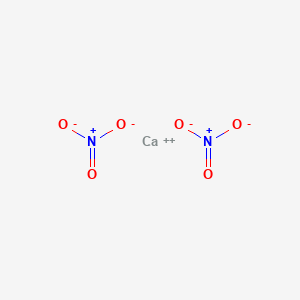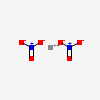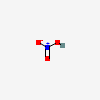Calcium nitrate
- Ca(NO3)2
- CaN2O6
- CALCIUM NITRATE
- 10124-37-5
- Calcium dinitrate
- Lime nitrate
- Nitric acid, calcium salt
- Create:2005-08-08
- Modify:2025-01-18

10124-37-5 (anhydrous)
13477-34-4 (tetrahydrate)
- calcium nitrate
- calcium nitrate tetrahydrate
- CALCIUM NITRATE
- 10124-37-5
- Calcium dinitrate
- Lime nitrate
- Nitric acid, calcium salt
- Norwegian saltpeter
- Lime saltpeter
- Norge saltpeter
- calcium;dinitrate
- Calcium saltpeter
- Calcium(II) nitrate (1:2)
- NF52F38N1N
- Nitrocalcite
- DTXSID1039719
- CHEBI:64205
- Saltpeter [Norway]
- 10124-37-5(anhydrous); 13477-34-4(tetrahydrate)
- Synfat 1006
- HSDB 967
- EINECS 233-332-1
- UNII-NF52F38N1N
- Nitric acid calcium salt (2:1)
- calcium nitrate salt
- anhydrous calcium nitrate
- EC 233-332-1
- Ca(NO3)2
- CALCIUM NITRATE [MI]
- CALCIUM NITRATE [HSDB]
- CHEMBL3183960
- DTXCID9019719
- BCP25810
- Tox21_300814
- AKOS015913857
- Calcium nitrate, containing in the anhydrous state more than 16 per cent by weight of nitrogen
- Calcium nitrate [UN1454] [Oxidizer]
- NCGC00248379-01
- NCGC00254718-01
- CAS-10124-37-5
- NS00093508
- Q407392
- 10124-37-5(anhydrous)13477-34-4(tetrahydrate)
- Calcium standard for AAS, analytical standard, ready-to-use, traceable to BAM, in nitric acid
- Adhesion/cohesion promoter
- Surface modifier
- Viscosity modifiers
- Not Known or Reasonably Ascertainable
- Intermediates
- Fuels and fuel additives
- Processing aids not otherwise specified
- Process regulators
- Soil amendments (fertilizers)
- Drier
- Odor agents
- Agricultural chemicals (non-pesticidal)
- Processing aids, not otherwise listed
- Viscosity modifiers
- Pigment
- Not Known or Reasonably Ascertainable
- Intermediates
- Fuels and fuel additives
- Process regulators
- Soil amendments (fertilizers)
- Drier
- Odor agents
- Agricultural chemicals (non-pesticidal)
- Chemical reaction regulator
- Processing aids, not otherwise listed
Information on 2 consumer products that contain Calcium nitrate in the following categories is provided:
• Landscaping/Yard
2019: 250,000,000 - <500,000,000 lb
2018: 250,000,000 - <500,000,000 lb
2017: 250,000,000 - <500,000,000 lb
2016: 250,000,000 - <500,000,000 lb
- Computer and Electronic Product Manufacturing
- Utilities
- Rubber Product Manufacturing
- Fabricated Metal Product Manufacturing
- Construction
- Non-metallic Mineral Product Manufacturing (includes clay, glass, cement, concrete, lime, gypsum, and other non-metallic mineral product manufacturing)
- Not Known or Reasonably Ascertainable
- Plastics Material and Resin Manufacturing
- Wholesale and Retail Trade
- Electrical Equipment, Appliance, and Component Manufacturing
- Agriculture, Forestry, Fishing and Hunting
- Machinery Manufacturing
- Transportation Equipment Manufacturing
- Pesticide, Fertilizer, and Other Agricultural Chemical Manufacturing
- All Other Basic Inorganic Chemical Manufacturing



H272 (27.2%): May intensify fire; oxidizer [Danger Oxidizing liquids; Oxidizing solids]
H290 (13.5%): May be corrosive to metals [Warning Corrosive to Metals]
H302 (53.2%): Harmful if swallowed [Warning Acute toxicity, oral]
H314 (13.5%): Causes severe skin burns and eye damage [Danger Skin corrosion/irritation]
H315 (44.3%): Causes skin irritation [Warning Skin corrosion/irritation]
H318 (44.3%): Causes serious eye damage [Danger Serious eye damage/eye irritation]
H319 (47.9%): Causes serious eye irritation [Warning Serious eye damage/eye irritation]
H332 (13.6%): Harmful if inhaled [Warning Acute toxicity, inhalation]
P210, P220, P234, P260, P261, P264, P264+P265, P270, P271, P280, P301+P317, P301+P330+P331, P302+P352, P302+P361+P354, P304+P340, P305+P351+P338, P305+P354+P338, P316, P317, P321, P330, P332+P317, P337+P317, P362+P364, P363, P370+P378, P390, P405, P406, and P501
(The corresponding statement to each P-code can be found at the GHS Classification page.)
Aggregated GHS information provided per 1268 reports by companies from 26 notifications to the ECHA C&L Inventory. Each notification may be associated with multiple companies.
Reported as not meeting GHS hazard criteria per 4 of 1268 reports by companies. For more detailed information, please visit ECHA C&L website.
There are 25 notifications provided by 1264 of 1268 reports by companies with hazard statement code(s).
Information may vary between notifications depending on impurities, additives, and other factors. The percentage value in parenthesis indicates the notified classification ratio from companies that provide hazard codes. Only hazard codes with percentage values above 10% are shown.
Ox. Sol. 3 (27.2%)
Met. Corr. 1 (13.5%)
Acute Tox. 4 (53.2%)
Skin Corr. 1B (13.5%)
Skin Irrit. 2 (44.3%)
Eye Dam. 1 (44.3%)
Eye Irrit. 2 (47.9%)
Acute Tox. 4 (13.6%)
Oxidizing solids - Category 3
Specific target organ toxicity - Single exposure - Category 1 (blood)
Specific target organ toxicity - Repeated exposure - Category 1 (blood)
· Inhalation, ingestion or contact (skin, eyes) with vapors or substance may cause severe injury, burns or death.
· Fire may produce irritating, corrosive and/or toxic gases.
· Runoff from fire control or dilution water may cause environmental contamination.
Special Hazards of Combustion Products: May give off toxic oxides of nitrogen when involved in fire.
Behavior in Fire: Greatly intensifies the burning of all combustible materials. (USCG, 1999)
CAUTION: Ammonium nitrate products may explode if involved in fire or contaminated with hydrocarbons (fuels), organic matter, other contaminants or when hot molten and contained. Treat as an explosive (GUIDE 112).
· These substances will accelerate burning when involved in a fire.
· Some may decompose explosively when heated or involved in a fire.
· May explode from heat or contamination.
· Some will react explosively with hydrocarbons (fuels).
· May ignite combustibles (wood, paper, oil, clothing, etc.).
· Containers may explode when heated.
· Runoff may create fire or explosion hazard.
General First Aid:
· Call 911 or emergency medical service.
· Ensure that medical personnel are aware of the material(s) involved, take precautions to protect themselves and avoid contamination.
· Move victim to fresh air if it can be done safely.
· Administer oxygen if breathing is difficult.
· If victim is not breathing:
-- DO NOT perform mouth-to-mouth resuscitation; the victim may have ingestedor inhaled the substance.
-- If equipped and pulse detected, wash face and mouth, then give artificial respiration using a proper respiratory medical device (bag-valve mask, pocket mask equipped with a one-way valve or other device).
-- If no pulse detected or no respiratory medical device available, provide continuouscompressions. Conduct a pulse check every two minutes or monitor for any signs of spontaneous respirations.
· Remove and isolate contaminated clothing and shoes.
· For minor skin contact, avoid spreading material on unaffected skin.
· In case of contact with substance, remove immediately by flushing skin or eyes with running water for at least 20 minutes.
· For severe burns, immediate medical attention is required.
· Effects of exposure (inhalation, ingestion, or skin contact) to substance may be delayed.
· Keep victim calm and warm.
· Keep victim under observation.
· For further assistance, contact your local Poison Control Center.
· Note: Basic Life Support (BLS) and Advanced Life Support (ALS) should be done by trained professionals.
Specific First Aid:
· Contaminated clothing may be a fire risk when dry.
In Canada, an Emergency Response Assistance Plan (ERAP) may be required for this product. Please consult the shipping paper and/or the "ERAP" section.
Excerpt from ERG Guide 140 [Oxidizers]:
SMALL FIRE: Use water. Do not use dry chemicals or foams. CO2 or Halon® may provide limited control.
LARGE FIRE: Flood fire area with water from a distance. Do not move cargo or vehicle if cargo has been exposed to heat. If it can be done safely, move undamaged containers away from the area around the fire.
FIRE INVOLVING TANKS, RAIL TANK CARS OR HIGHWAY TANKS: For ammonium nitrate products: Do not fight cargo fire. Withdraw, evacuate and isolate area for at least 1600 meters (1 mile). Treat as an explosive (ERG Guide 112). Do not enter area for 24 hours or until expert advice has been provided. Fight fire from maximum distance or use unmanned master stream devices or monitor nozzles. Cool containers with flooding quantities of water until well after fire is out. ALWAYS stay away from tanks in direct contact with flames. For massive fire, use unmanned master stream devices or monitor nozzles; if this is impossible, withdraw from area and let fire burn. (ERG, 2024)
· CALL 911. Then call emergency response telephone number on shipping paper. If shipping paper not available or no answer, refer to appropriate telephone number listed on the inside back cover.
· Keep unauthorized personnel away.
· Stay upwind, uphill and/or upstream.
· Ventilate closed spaces before entering, but only if properly trained and equipped.
· Keep combustibles (wood, paper, oil, etc.) away from spilled material.
· Do not touch damaged containers or spilled material unless wearing appropriate protective clothing.
· Stop leak if you can do it without risk.
· Do not get water inside containers.
Small Dry Spill
· With clean shovel, place material into clean, dry container and cover loosely; move containers from spill area.
Small Liquid Spill
· Use a non-combustible material like vermiculite or sand to soak up the product and place into a container for later disposal.
Large Spill
· Dike far ahead of liquid spill for later disposal.
Excerpt from ERG Guide 140 [Oxidizers]:
IMMEDIATE PRECAUTIONARY MEASURE: Isolate spill or leak area in all directions for at least 50 meters (150 feet) for liquids and at least 25 meters (75 feet) for solids.
LARGE SPILL: Consider initial downwind evacuation for at least 100 meters (330 feet).
FIRE: If tank, rail tank car or highway tank is involved in a fire, ISOLATE for 800 meters (1/2 mile) in all directions; also, consider initial evacuation for 800 meters (1/2 mile) in all directions. If ammonium nitrate products are in a tank, rail car or truck and involved in a fire, ISOLATE for 1600 meters (1 mile) in all directions; also, initiate evacuation including emergency responders for 1600 meters (1 mile) in all directions. (ERG, 2024)
Immediate precautionary measure
· Isolate spill or leak area in all directions for at least 50 meters (150 feet) for liquids and at least 25 meters (75 feet) for solids.
Large Spill
· Consider initial downwind evacuation for at least 100 meters (330 feet).
Fire
· If tank, rail tank car or highway tank is involved in a fire, ISOLATE for 800 meters (1/2 mile) in all directions; also, consider initial evacuation for 800 meters (1/2 mile) in all directions.
· If ammonium nitrate products are in a tank, rail car or truck and involved in a fire, ISOLATE for 1600 meters (1 mile) in all directions; also, initiate evacuation including emergency responders for 1600 meters (1 mile) in all directions.
Excerpt from ERG Guide 140 [Oxidizers]:
Keep combustibles (wood, paper, oil, etc.) away from spilled material. Do not touch damaged containers or spilled material unless wearing appropriate protective clothing. Stop leak if you can do it without risk. Do not get water inside containers.
SMALL DRY SPILL: With clean shovel, place material into clean, dry container and cover loosely; move containers from spill area.
SMALL LIQUID SPILL: Use a non-combustible material like vermiculite or sand to soak up the product and place into a container for later disposal.
LARGE SPILL: Dike far ahead of liquid spill for later disposal. (ERG, 2024)
· Wear positive pressure self-contained breathing apparatus (SCBA).
· Wear chemical protective clothing that is specifically recommended by the manufacturer when there is NO RISK OF FIRE.
· Structural firefighters' protective clothing provides thermal protection but only limited chemical protection.
Small Fire
· Use water. Do not use dry chemicals or foams. CO2 or Halon® may provide limited control.
Large Fire
· Flood fire area with water from a distance.
· Do not move cargo or vehicle if cargo has been exposed to heat.
· If it can be done safely, move undamaged containers away from the area around the fire.
Fire Involving Tanks, Rail Tank Cars or Highway Tanks
· For ammonium nitrate products: Do not fight cargo fire. Withdraw, evacuate and isolate area for at least 1600 meters (1 mile). Treat as an explosive (GUIDE 112). Do not enter area for 24 hours or until expert advice has been provided.
· Fight fire from maximum distance or use unmanned master stream devices or monitor nozzles.
· Cool containers with flooding quantities of water until well after fire is out.
· ALWAYS stay away from tanks in direct contact with flames.
· For massive fire, use unmanned master stream devices or monitor nozzles; if this is impossible, withdraw from area and let fire burn.
IMAP assessments - Nitric acid, calcium salt: Human health tier I assessment
IMAP assessments - Nitric acid, calcium salt: Environment tier I assessment
Patents are available for this chemical structure:
https://patentscope.wipo.int/search/en/result.jsf?inchikey=ZCCIPPOKBCJFDN-UHFFFAOYSA-N
- Athena MineralsLICENSECopyright (c) ATHENA - Pierre Perroud. All Rights ReservedNitrocalcitehttps://athena.unige.ch/minfich?id=NITROCALCITE
- Handbook of Mineralogy
- RRUFF ProjectNitrocalcitehttps://rruff.info/Nitrocalcite
- Australian Industrial Chemicals Introduction Scheme (AICIS)Nitric acid, calcium salthttps://services.industrialchemicals.gov.au/search-assessments/Nitric acid, calcium salthttps://services.industrialchemicals.gov.au/search-inventory/
- CAMEO ChemicalsLICENSECAMEO Chemicals and all other CAMEO products are available at no charge to those organizations and individuals (recipients) responsible for the safe handling of chemicals. However, some of the chemical data itself is subject to the copyright restrictions of the companies or organizations that provided the data.https://cameochemicals.noaa.gov/help/reference/terms_and_conditions.htm?d_f=falseCALCIUM NITRATEhttps://cameochemicals.noaa.gov/chemical/2785CAMEO Chemical Reactivity Classificationhttps://cameochemicals.noaa.gov/browse/react
- ChemIDplusChemIDplus Chemical Information Classificationhttps://pubchem.ncbi.nlm.nih.gov/source/ChemIDplus
- EPA Chemical Data Reporting (CDR)LICENSEThe U.S. Government retains a nonexclusive, royalty-free license to publish or reproduce these documents, or allow others to do so, for U.S. Government purposes. These documents may be freely distributed and used for non-commercial, scientific and educational purposes.https://www.epa.gov/web-policies-and-procedures/epa-disclaimers#copyrightNitric acid, calcium salt (2:1)https://www.epa.gov/chemical-data-reporting
- EPA Chemicals under the TSCANitric acid, calcium salt (2:1)https://www.epa.gov/chemicals-under-tscaEPA TSCA Classificationhttps://www.epa.gov/tsca-inventory
- EPA DSSToxNitric acid, calcium salt (2:1)https://comptox.epa.gov/dashboard/DTXSID1039719CompTox Chemicals Dashboard Chemical Listshttps://comptox.epa.gov/dashboard/chemical-lists/
- European Chemicals Agency (ECHA)LICENSEUse of the information, documents and data from the ECHA website is subject to the terms and conditions of this Legal Notice, and subject to other binding limitations provided for under applicable law, the information, documents and data made available on the ECHA website may be reproduced, distributed and/or used, totally or in part, for non-commercial purposes provided that ECHA is acknowledged as the source: "Source: European Chemicals Agency, http://echa.europa.eu/". Such acknowledgement must be included in each copy of the material. ECHA permits and encourages organisations and individuals to create links to the ECHA website under the following cumulative conditions: Links can only be made to webpages that provide a link to the Legal Notice page.https://echa.europa.eu/web/guest/legal-noticeCalcium nitratehttps://chem.echa.europa.eu/100.030.289Calcium nitrate (EC: 233-332-1)https://echa.europa.eu/information-on-chemicals/cl-inventory-database/-/discli/details/80283
- FDA Global Substance Registration System (GSRS)LICENSEUnless otherwise noted, the contents of the FDA website (www.fda.gov), both text and graphics, are not copyrighted. They are in the public domain and may be republished, reprinted and otherwise used freely by anyone without the need to obtain permission from FDA. Credit to the U.S. Food and Drug Administration as the source is appreciated but not required.https://www.fda.gov/about-fda/about-website/website-policies#linking
- Hazardous Substances Data Bank (HSDB)CALCIUM NITRATEhttps://pubchem.ncbi.nlm.nih.gov/source/hsdb/967
- ILO-WHO International Chemical Safety Cards (ICSCs)
- New Zealand Environmental Protection Authority (EPA)LICENSEThis work is licensed under the Creative Commons Attribution-ShareAlike 4.0 International licence.https://www.epa.govt.nz/about-this-site/general-copyright-statement/
- NJDOH RTK Hazardous Substance Listcalcium nitratehttp://nj.gov/health/eoh/rtkweb/documents/fs/0324.pdf
- Emergency Response Guidebook (ERG)Calcium nitratehttps://pubchem.ncbi.nlm.nih.gov/erg/
- Haz-Map, Information on Hazardous Chemicals and Occupational DiseasesLICENSECopyright (c) 2022 Haz-Map(R). All rights reserved. Unless otherwise indicated, all materials from Haz-Map are copyrighted by Haz-Map(R). No part of these materials, either text or image may be used for any purpose other than for personal use. Therefore, reproduction, modification, storage in a retrieval system or retransmission, in any form or by any means, electronic, mechanical or otherwise, for reasons other than personal use, is strictly prohibited without prior written permission.https://haz-map.com/AboutCalcium nitratehttps://haz-map.com/Agents/1467
- ChEBICalcium nitratehttps://www.ebi.ac.uk/chebi/searchId.do?chebiId=CHEBI:64205
- Toxin and Toxin Target Database (T3DB)LICENSET3DB is offered to the public as a freely available resource. Use and re-distribution of the data, in whole or in part, for commercial purposes requires explicit permission of the authors and explicit acknowledgment of the source material (T3DB) and the original publication.http://www.t3db.ca/downloadsCalcium nitratehttp://www.t3db.ca/toxins/T3D3554
- ChEMBLLICENSEAccess to the web interface of ChEMBL is made under the EBI's Terms of Use (http://www.ebi.ac.uk/Information/termsofuse.html). The ChEMBL data is made available on a Creative Commons Attribution-Share Alike 3.0 Unported License (http://creativecommons.org/licenses/by-sa/3.0/).http://www.ebi.ac.uk/Information/termsofuse.html
- Consumer Product Information Database (CPID)LICENSECopyright (c) 2024 DeLima Associates. All rights reserved. Unless otherwise indicated, all materials from CPID are copyrighted by DeLima Associates. No part of these materials, either text or image may be used for any purpose other than for personal use. Therefore, reproduction, modification, storage in a retrieval system or retransmission, in any form or by any means, electronic, mechanical or otherwise, for reasons other than personal use, is strictly prohibited without prior written permission.https://www.whatsinproducts.com/contents/view/1/6Consumer Products Category Classificationhttps://www.whatsinproducts.com/
- Crystallography Open Database (COD)LICENSEAll data in the COD and the database itself are dedicated to the public domain and licensed under the CC0 License. Users of the data should acknowledge the original authors of the structural data.https://creativecommons.org/publicdomain/zero/1.0/
- EPA Chemical and Products Database (CPDat)EPA CPDat Classificationhttps://www.epa.gov/chemical-research/chemical-and-products-database-cpdat
- NITE-CMCCalcium nitrate - FY2010 (Revised classification)https://www.chem-info.nite.go.jp/chem/english/ghs/10-mhlw-2024e.htmlCalcium nitrate - FY2009 (New/original classication)https://www.chem-info.nite.go.jp/chem/english/ghs/09-mhlw-0052e.html
- Human Metabolome Database (HMDB)LICENSEHMDB is offered to the public as a freely available resource. Use and re-distribution of the data, in whole or in part, for commercial purposes requires explicit permission of the authors and explicit acknowledgment of the source material (HMDB) and the original publication (see the HMDB citing page). We ask that users who download significant portions of the database cite the HMDB paper in any resulting publications.http://www.hmdb.ca/citingCalcium nitratehttp://www.hmdb.ca/metabolites/HMDB0302952
- Springer Nature
- Wikidatacalcium nitratehttps://www.wikidata.org/wiki/Q407392
- Wikipediacalcium nitratehttps://en.wikipedia.org/wiki/Calcium_nitrateNitrocalcitehttps://en.wikipedia.org/wiki/Nitrocalcite
- Wiley
- PubChem
- Medical Subject Headings (MeSH)LICENSEWorks produced by the U.S. government are not subject to copyright protection in the United States. Any such works found on National Library of Medicine (NLM) Web sites may be freely used or reproduced without permission in the U.S.https://www.nlm.nih.gov/copyright.htmlcalcium nitratehttps://www.ncbi.nlm.nih.gov/mesh/67059948
- GHS Classification (UNECE)GHS Classification Treehttp://www.unece.org/trans/danger/publi/ghs/ghs_welcome_e.html
- NORMAN Suspect List ExchangeLICENSEData: CC-BY 4.0; Code (hosted by ECI, LCSB): Artistic-2.0https://creativecommons.org/licenses/by/4.0/NORMAN Suspect List Exchange Classificationhttps://www.norman-network.com/nds/SLE/
- EPA Substance Registry ServicesEPA SRS List Classificationhttps://sor.epa.gov/sor_internet/registry/substreg/LandingPage.do
- MolGenieMolGenie Organic Chemistry Ontologyhttps://github.com/MolGenie/ontology/
- PATENTSCOPE (WIPO)SID 403029883https://pubchem.ncbi.nlm.nih.gov/substance/403029883
- NCBI

 CID 5460341 (Calcium)
CID 5460341 (Calcium) CID 944 (Nitric Acid)
CID 944 (Nitric Acid)